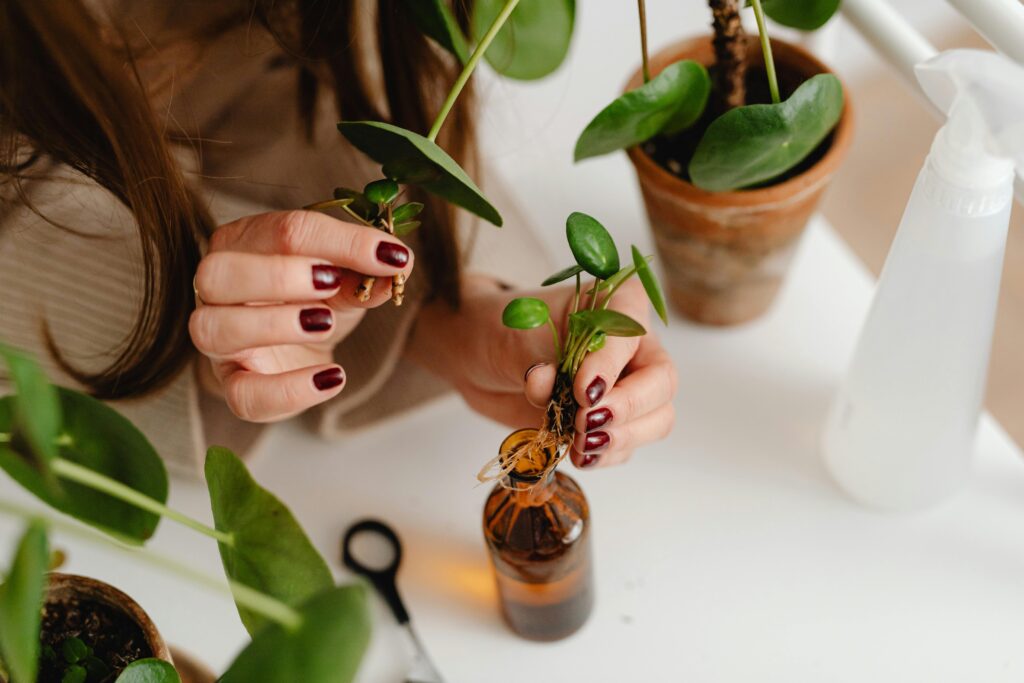Starting Seeds Indoors
Starting Seeds Indoors
| Essential Items | Desired Items |
|---|---|
| Seeds | Grow Light |
| Starter Soil | Heat Mat |
| Pots and trays | Grow Dome |
| Water Soluble Fertalizer | Grow Dome |

Introduction
What could be better than the special satisfaction that comes from harvesting the bounty of a spectacular plant that was once only a tiny speck of a seed in the palm of your hand? Well, perhaps it’s knowing that you can buy a packet of seeds which will grow 50 plants for about the same price it would cost to buy one … or that you can choose exactly the varieties you want for an earlier harvest, a better flavor, or a more beautiful color. Or maybe because you want to know that you have the healthiest, most vigorous seedlings available to take full advantage of our challenging climate. Whatever your reason, this article will provide you with some useful, straightforward tips that will help you successfully navigate the seed starting process.
There are five basic requirements for successful seed starting: good seeds, good light, good starting medium, proper watering and, finally, a sense of adventure. Let’s take a look at these important points one at a time.
Germination Test
· Place ten seeds and on a dampened paper towel.
· Roll up the paper towel with the seeds inside and place it inside a plastic bag.
· Partially close the plastic bag – do not seal.
· Place in a warm place (top of a refrigerator) and check every couple of days. Add moisture to keep towel damp if necessary.
· After ten days or so count how many seeds have germinated, multiply by ten and you have the germination rate. For rates under 70% adjust the number of seeds you sow accordingly.
Good Seeds
No matter how careful you are with all the other aspects of seed starting you will not be satisfied with the results unless you have heeded the call for good seeds. None of the other factors can compensate for seeds that are not strong and vigorous. Most seed companies provide high quality, healthy seeds because their livelihood depends on customers purchasing again next year.
If you have any concerns about the quality of seeds you have purchased or saved, try this simple germination test (see side-bar).
Good Light
Adequate light is essential to ensure sturdy, strong seedlings ready to take on the rigors of the Idaho climate. Even a bright, sunny window does not provide sufficient light to avoid leggy, weak-stemmed seedlings. One system many people have used with excellent results is simple and inexpensive: suspend
a standard shop light with florescent bulbs so that the lights are never more than 3 inches from the plants. Hang the lights from a ceiling or from the shelves of a multi-tiered plant stand. Special full spectrum plant bulbs are available at Town & Country that mimic the sun almost perfectly for improved results.
For optimal growth most plants require 16-18 hours of light with a few hours of rest. (A timer is handy for this purpose.) As the seedlings grow, be sure to repot them in larger pots so they don’t crowd one another. This provides more root space and gives the leaves more surface area exposed to the light. A final hint: if you use regular florescent bulbs you should replace them each year with new ones so that the light is as intense as possible.
Good Planting Medium
This is an easy one – don’t use soil! Do use a top quality, light, soil-free planting mix, many types of which are readily available at Town & Country Gardens. A soil-free planting mix is preferred for several reasons; it is light and open to encourage those tiny sprouts to push up to the surface, it can hold generous amounts of water without becoming water-logged, and because it is sterilized it will not harbor the harmful fungi which cause damping off disease. If you are going to re-use planting containers from last year be sure to disinfect them in a 9 to 1 water to bleach solution
Proper Watering
This aspect of starting seeds is probably the most troublesome. It requires some practice (and not a few failures) to get the hang of what we gardeners mean when we say, “Keep them wet enough, but not too wet!” The best explanation is that the soil should be consistently moist but not at all soggy. It is OK for the surface to be a bit dry but if the leaves are beginning to droop or a shiny leaf is starting to look dull, the roots do not have adequate moisture down deep. While it is probably better to err on the side of too little water rather than too much, either extreme will stress the plants and produce weaker seedlings.
One excellent method for watering seedlings is bottom watering. This avoids wetting the leaves and assures even and thorough watering of the planting medium. Use a large (approx. 48xl8x5″) plastic container for this purpose–this size is especially handy for 6-cell planters– but any flat container that meets your needs will suffice. Just add 2-4″ of un-softened water to the container and set your pots into the water. The water will slowly filter upwards through the planting medium until the surface is wet. As soon as you begin to see the surface darkening, lift the pots from the water, drain for a moment or two, and return them to their place under the lights.
When the seeds are newly planted and covered with plastic you will need to water much less frequently than when the plants have grown to 5 or 6″ and have more leaf surface area transpiring. Watch carefully during your first seed-starting season and you will soon get the hang of it.
Planting
Getting the seeds in the planting mix is one of the most enjoyable parts of the process. You will need the following materials:
- Planting containers – 6-cell planters are the most popular but you can use almost any container that has good Town & Country has a large selection of convenient trays, cell planters, peat pots and plastic domes.
- Plant markers for identifying the
- A notebook for keeping records of when, how and what you’ve done each
- Good seeds!
Fill the containers with planting mix and pack it down gently. Check seed packets for proper planting depth, plant several seeds in each container, and cover with planting mix according to the directions. (Later, after the seedlings have their first set of true leaves, you will either transplant the extras or clip them out with a pair of small scissors.) Gently water each individual container thoroughly, label each container, and then cover with a clear plastic bag or a clear plastic dome. Put into a warm place like the top of your refrigerator. If you are germinating a lot of seeds, you can use an electric blanket covered with a plastic shower curtain, but be careful that they don’t get too hot. Use a thermometer to calibrate the soil temperature so that it’s maintained at 72-75 degrees. Convenient germinating mats with automatic thermostats are also available at Town & Country. Although more expensive, they work extremely well and last for years.
While most seed varieties germinate in the dark, some do require light … so read the packets carefully! To plant seeds that need light to germinate, sprinkle them on the surface of the planting medium and water very gently. Also, some seeds will germinate in 3-4 days while others need up to a month! So keep a close eye on your planters because as soon as the seedlings are up the plastic dome should be removed and they need to be moved immediately under lights. Be sure to check on the moisture level regularly.
Here are some other seed starting tips to ensure good results:
Feeding Seedlings
Once your seedlings have their first set of true leaves you can begin feeding them at every watering. We recommend Ferti-lome Water Soluble Plant Food. But be sure to use it at the milder potted plant rate (1 teaspoon per gallon of water).
Hardening Off
It will make you crazy if you successfully get your plants to the point at which they are ready to go outside and then you damage or kill them by skipping this critical step. So………. even though
you are really eager to plant them outdoors, please take the time to follow this final step. The process of hardening off (which readies the plant to withstand the rigors of the outdoors) can be accomplished in about 4 days. Start by taking the plants outside on a calm day for about an hour. Then bring them back indoors under the lights. Repeat the process each day doubling the time until they are out all day. Now they are ready to go into the soil. If the weather gets particularly cold or windy you may want to abort the process and begin again when the weather improves.
Indoor Seed Sowing Guide
| Varieties | Indoor Sow Date | Outdoor Planting Date | Days to Germination | Comments |
|---|---|---|---|---|
| Flowers | ||||
| Perennialsa | 2-15 to 4-15 | 4-15 to 6-15 | Varies | Timing varies by variety. |
| Ageratum | 3-1 to 4-1 | 5-15 to 6-15 | 10-15 | Don’t cover seed. Needs light to germinate. |
| Alyssum | 3-1 to 4-15 | 5-1 to 6-15 | 10-15 | Use warm water. |
| Aster* | 3-15 to 4-15 | 5-15 to 6-15 | 10-15 | Lightly cover seed. |
| Begonia* | 1-1 to 3-1 | 5-15 to 6-15 | 5-10 | Don’t cover seed. |
| Calendula | 3-15 to 5-15 | 4-15 to 6-15 | 10-15 | Lightly cover seed. |
| Carnation | 2-15 to 4-15 | 4-15 to 6-15 | 15-20 | Warm (70°) soil is critical. |
| Celosia* | 4-1 to 5-1 | 5-15 to 6-15 | 10-15 | Likes warm temperatures. |
| Coleus* | 3-15 to 4-15 | 5-15 to 6-15 | 10-15 | Don’t cover seed. Pinch off flowers. |
| Dahlia* | 3-1 to 4-1 | 5-15 to 6-15 | 5-15 | Lightly cover seed. |
| Daisy | 3-1 to 5-1 | 4-15 to 6-15 | 10-20 | Timing varies by variety. |
| Dianthus | 2-15 to 4-1 | 5-1 to 6-15 | 10-15 | Prefer cool air temperatures. |
| Geranium* | 1-15 to 3-1 | 5-15 to 6-15 | 5-15 | Cover seed lightly. |
| Godetia | 3-1 to 5-1 | 4-15 to 6-15 | 5-10 | Give plenty of light and cool temps |
| Impatiens* | 3-1 to 4-1 | 5-15 to 6-15 | 20-30 | Don’t cover seed. Needs warm soil. |
| Lobelia | 2-1 to 3-15 | 5-1 to 6-15 | 15-20 | Use warm water. |
| Marigold* | 3-15 to 4-15 | 5-15 to 6-15 | 5-15 | Very easy to start. |
| Pansy | 1-15 to 3-1 | 4-1 to 5-15 | 10-15 | Requires darkness until germinated. |
| Petunia | 2-15 to 4-1 | 5-1 to 6-15 | 10-15 | Don’t cover seed. Needs warm soil. |
| Phlox | 3-1 to 5-1 | 4-15 to 6-15 | 10-15 | Requires darkness and cool soil (60-65°) |
| Portulaca* | 3-1 to 4-1 | 5-15 to 6-15 | 10-15 | Likes warm soil (75-80°) |
| Salvia* | 3-1 to 4-1 | 5-15 to 6-15 | 5-15 to 6-15 | Don’t cover seed |
| Snapdragon | 2-15 to 4-15 | 4-15 to 6-15 | 10-15 | Chill seed for several days before sowing. |
| Verbena | 2-15 to 4-15 | 4-15 to 6-15 | 20 | Requires darkness until germinated. |
| Zinnia | 4-15 to 5-15 | 5-15 to 6-15 | 5-10 | Cover seed lightly. |
| Vegetables | ||||
| Celery | 2-15 to 3-15 | 5-15 to 6-15 | 20-25 | |
| Chives | 3-1 to 4-1 | 5-1 to 6-1 | 10-25 | If plants stretch, cut back half way. |
| Cole Cropsb | 3-1 to 4-1 | 5-1 to 6-1 | 5-15 | Transplant deeply (up to seed leaves). |
| Cucurbitsc* | 5-1 to 6-1 | 5-15 to 6-15 | 5-10 | Transplant best when young. |
| Eggplant* | 3-15 to 4-15 | 5-15 to 6-15 | 10-20 | |
| Onion | 2-15 to 3-15 | 4-15 to 5-15 | 10-15 | If plants stretch, cut back half way. |
| Parsley | 2-15 to 3-15 | 5-1 to 6-1 | 20-30 | Cover seed. Slow to germinate. |
| Pepper* | 3-1 to 4-1 | 5-15 to 6-15 | 15-20 | |
| Tomato* | 3-15 to 4-15 | 5-15 to 6-15 | 5-15 |
Dates given are guidelines. You may adjust planting dates for variations in plant size and weather conditions.
a Perennials can also be sown in mid July for planting out in September.
b Cole Crops include broccoli, brussel sprouts, cabbage, cauliflower, and kohlrabi.
c Cucurbits include cantaloupe, cucumbers, pumpkins, squash, watermelon.
*Plants listed with an asterisk are tender and may require protection from late frosts. Other varieties will tolerate some frost (usually to about 25°).


